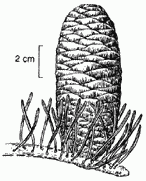 Foliage & cone [L.A. Vorobik] (5). | Abies lowiana (Gordon) A. Murray 1863Common NamesCalifornia white fir, Sierra white fir (3).Taxonomic notesSyn: Picea lowiana Gordon 1862; Abies concolor (Gordon & Glendinning) Hildebrand var. lowiana (Gordon) Lemmon (3).DescriptionTrees to 60 m tall and 190 cm dbh.; crown somewhat spirelike, becoming somewhat flat-topped with age. Bark gray, thin, smooth, with age thickening and breaking into deep longitudinal furrows ("corky"), which may reveal inner yellow-caramel periderm. Branches diverging from trunk at right angles, or slightly drooping; twigs mostly opposite, yellow-green, pubescent or glabrous. Buds exposed, tan, globose, resinous, moderately large, apex rounded; basal scales short, broad, equilaterally triangular, sparsely pubescent, not resinous, margins entire, apex sharp-pointed. Leaves 2-6 cm × 2-3 mm, mostly 2-ranked, flexible, proximal portion ± straight; cross section flat, grooved adaxially; odor pungent, pinelike; abaxial surface glaucous or not, with 5-8 stomatal rows on each side of midrib; adaxial surface light green, not glaucous, with ca. (5)7(9) stomatal rows at midleaf, these fewer toward leaf apex; apex weakly notched; resin canals small, near margins and abaxial epidermal layer. Seed cones cylindric, 8-9 × 4-4.5 cm, olive-green, turning to yellowish brown, then darker brown, sessile, apex round; scales ca. 2.5-3 × 2.8-3.8 cm, pubescent; bracts included. Seeds 8-12 × 3 mm, body dull brown; wing about twice as long as body, brown with rosy tinge; cotyledons 5-9 (3).RangeUSA: California and Nevada at 900-2300 m in mixed conifer forests (3). Silba (1) also places it in USA: SW Oregon and Mexico: N Baja California Norte (see Observations).Big TreeHeight 66.1 m, dbh 223 cm, in Yosemite National Park, CA (2).Height 75.3 m, dbh 148 cm, in Yosemite National Park, CA (4). OldestDendrochronologyEthnobotanyObservationsHave seen the forests of Baja California Norte, atop the Sierra San Pedro Martír. This is one of the most extraordinary forests of large conifers left in North America, because it has not been subject to fire suppression. Consequently, it remains a large area of open, parklike stands of conifers (mostly Abies lowiana, Pinus coulteri, P. jeffreyi, and P. lambertiana). It is most readily accessed by a good quality gravel road ascending the west slope of the range to a national astronomical observatory maintained atop the range crest. The road leaves the Transpeninsular Highway 140 km south of Ensenada and (in 1994) is signed "Observatorio". The forest starts around the park entrance, 75 km from the highway, and continues beyond road's end at the observatory, 20 km further on. Camping is superb but water is scarce.RemarksCitations(1) Silba 1986.(2) E-mail communication from Robert Van Pelt, who measured this tree (as A. concolor); 18-Mar-1998. (3) Richard S. Hunt at the Flora of North America web site. (4) Mitchell, A.F. 1990. Trees of North America (as A. concolor). (5) Hickman 1993. See also Vidakovic 1991. |
[Abies] [Pinaceae] [home] This page is from the Gymnosperm Database |